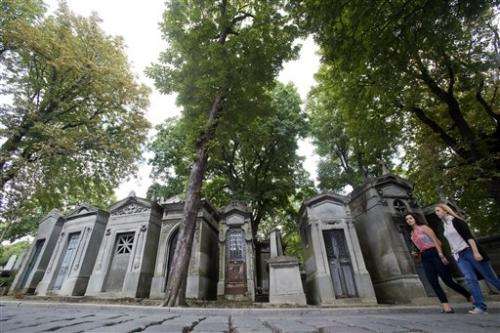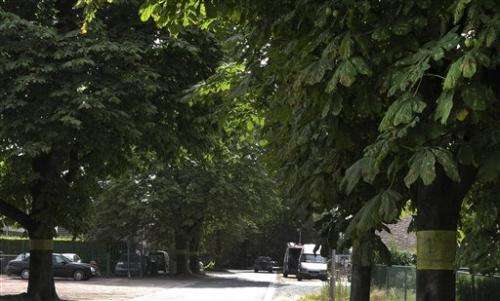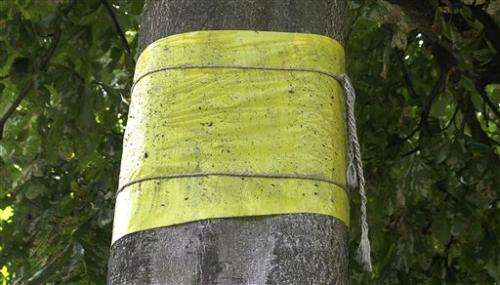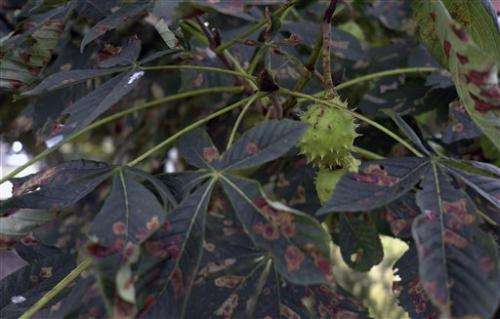The great chestnut trees of Europe are dying

(AP)—Visit the Pere Lachaise cemetery in Paris and chestnut trees greet you as you wander among graves of luminaries such as Oscar Wilde and Jim Morrison.
When Anne Frank was in hiding from the Nazis in Amsterdam, the view of a monumental chestnut tree was one thing that cheered her up.
In Cambridge, England, the two-century-old chestnut standing outside King's College chapel has become a beloved icon.
In all those places—and over much of Europe—the horse chestnut tree is under threat.
Sometimes they crash across boulevards and smash cars, unable to bear the weight of their own foliage. At other times, city officials move in and cut them down before they collapse.
In high summer, their leaves can become so rusty it feels like October. As autumn approaches, many stand naked while other trees still wear their crowns of green.
The culprits: a moth that produces leaf-eating larvae and a bacterium that makes trunks bleed and die.

"In a sense it is almost like a lethal cocktail," said Dr. Darren Evans of the University of Hull. "If it is under attack by moths, it is probably going to be more susceptible to this bleeding canker—which will kill it."
A cure? Not immediately in sight.
"It is spread throughout most of northern Europe," Evans said of the leaf miner moth in a telephone interview. "We still don't really know whether there is any effective way of controlling it." The same goes for the bacteria.
Without any clear reason, the moth became rampant and spread through much of Europe about a decade ago. In Britain, it first surfaced in Wimbledon in 2002 and soon spread across England and Wales. It has flourished across the continent. The moth lays eggs in leaves and the larvae start devouring them, causing foliage to turn color as soon as July.
The rusting robs the tree of vital sunlight for key months and, weakened, some fall prey to other diseases such as fungi.

The moth was soon joined by a bacterium that came from the Himalayas and causes chestnut bark to bleed an oozing sticky liquid, sapping the tree and in many cases causing death.
"The worst case scenario is that we lose most of our horse chestnut trees to this bleeding canker," Evans said.
In Britain, which has up to 2 million chestnut trees, a 2007 survey showed that up to half could be infected with the disease. In countries like Belgium, France and the Netherlands, the alarm has also been raised.
There is historical precedent for the fears: At the turn of the 20th century a fungus caused a mass extinction of the American chestnut tree in the eastern United States.
Europe's chestnuts came first from the Balkans and were introduced in western Europe about 500 years ago. It is a hallmark of cities rather than forests and, especially during the Victorian era, became a favorite for stately lanes, parks and squares.

In Ghent, Belgium, last month, a huge chestnut suddenly collapsed along the upper Scheldt river, smashing a car along a road usually busy with cycling students. As in many places, city councils have been increasingly checking the health of chestnuts and, if there's any doubt, cut them down as a safety precaution.
The chestnuts are all gone this summer from the city's Groentenmarkt medieval center, depriving weary tourists of reprieve from the sun.
The chestnuts, or marroniers, in Paris are also part of the attraction at Pere Lachaise. But last year, visitors could walk ankle deep through rusty leaves in the middle of July.
"It's a problem all over Paris," said cemetery conservator Martine Lecuyer, although she said heavy rainfall made this year a little better.
In Amsterdam, officials are scrambling to try to save chestnuts within the famed canal belt. For Anne Frank's tree, help came too late. The 150-year-old tree, affected by the moth and fungi, weakened progressively and crashed to the ground two years ago.
If the darkest predictions prove true, many Britons will mourn chestnut trees as the passing of part of their youth: The game of "conkers," in which children take turns trying to smash chestnuts, was once a popular pastime on playgrounds across the country.
Just as bad for chestnuts is the way people deal with the problem: On Ghent's Groentenmarkt, the new trees are now linden, and the example is followed in many parts of Europe.
"Many local authorities are then no longer planting horse chestnut trees because they fear—what is the point in planting something that is going to be susceptible to attack," Evans said.
"Essentially, we could lose an entire new generation of horse chestnut trees."
Copyright 2012 The Associated Press. All rights reserved. This material may not be published, broadcast, rewritten or redistributed.










.jpg)







